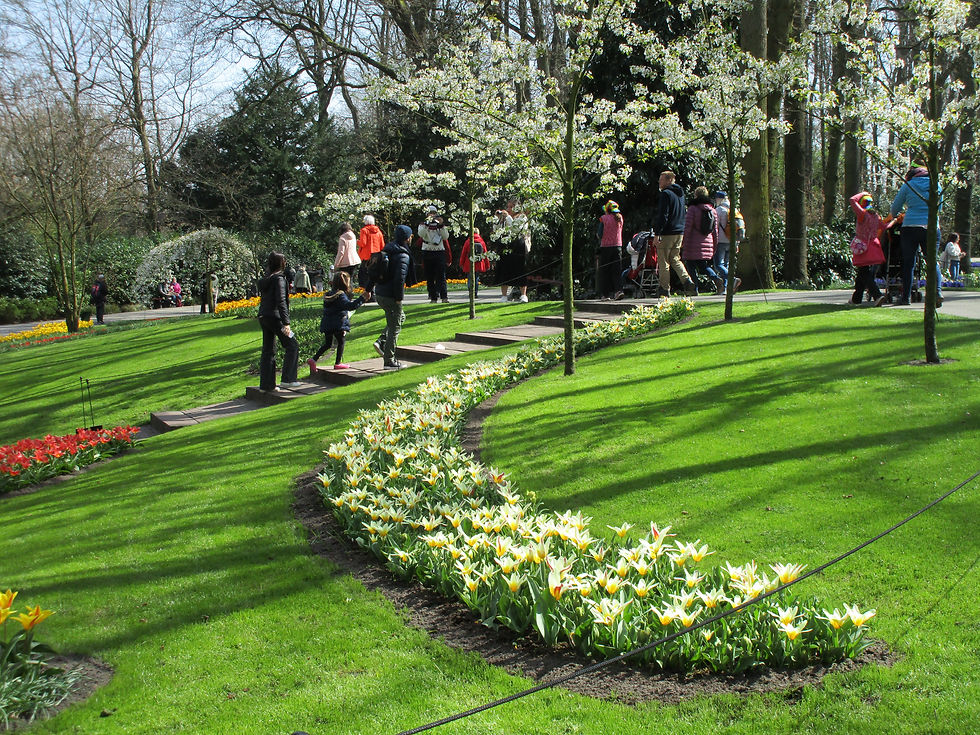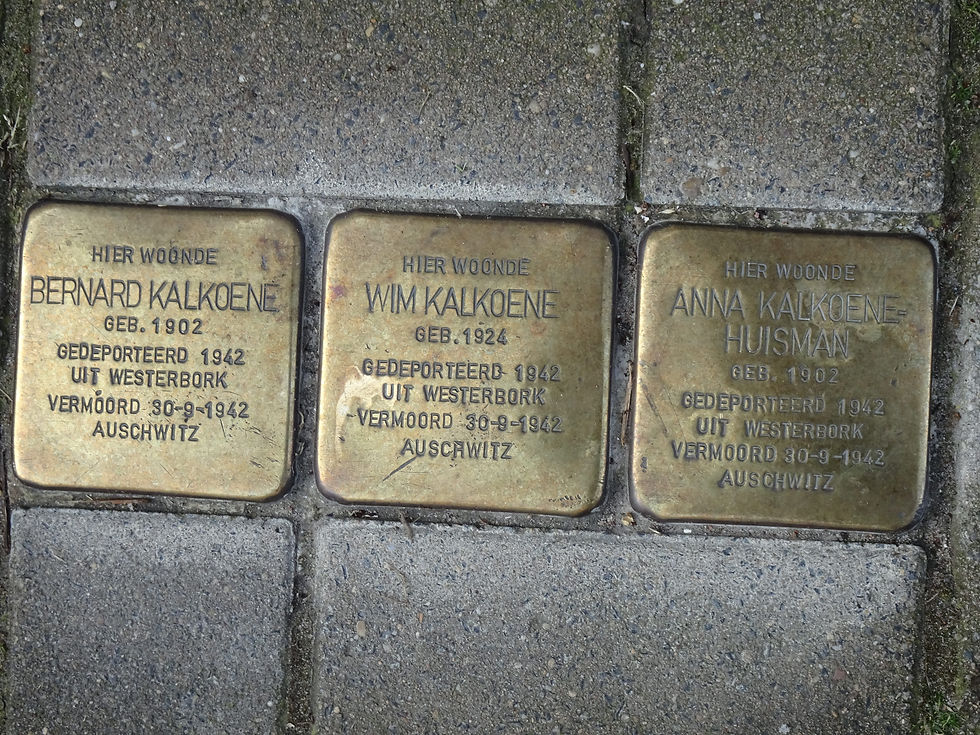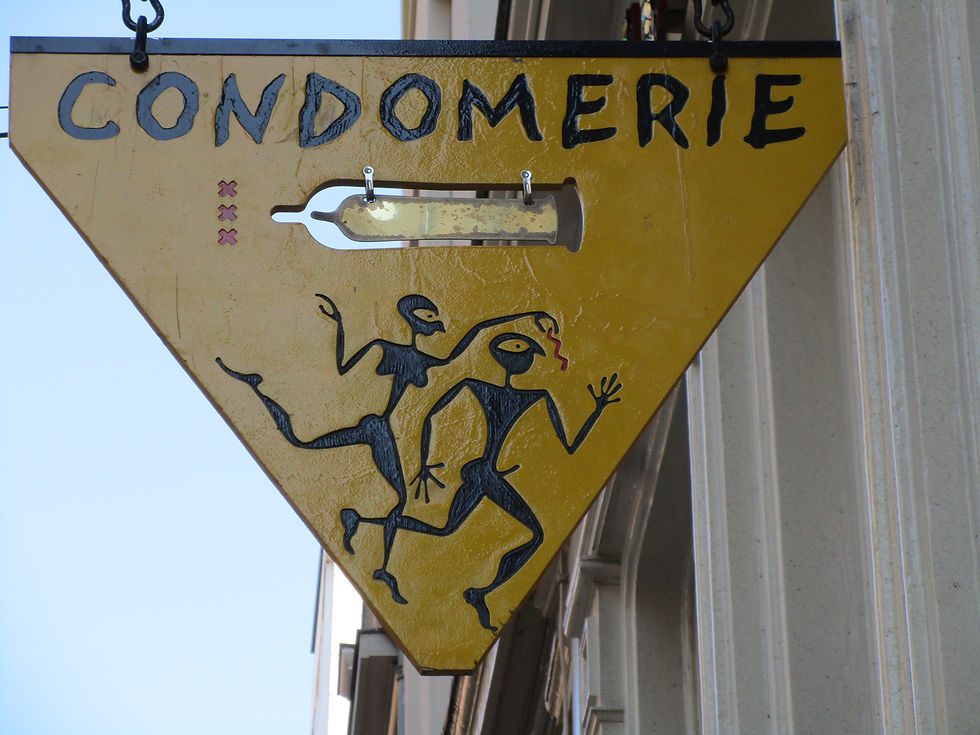- kiehart

- Jul 31, 2023
- 5 min read
Updated: Aug 1, 2023
Thank you for continuing with me on my Amsterdam vacay. Here are the last five bullet points, as promised. In case you missed July's post, click here: www.judykiehart.com/post/when-in-rome
6. Keukenhof Gardens
We planned the trip so that we'd be in Amsterdam during the tulip blooming period (March through May) and purchased tickets to the Keukenhof Gardens long before boarding the flight from the Pacific Northwest. Our timing was great! During the first week in April, about 95% of the tulips, daffodils, and hyacinths were in bloom. Did you know there are over 800 tulip varieties?

In the course of about five hours, we leisurely walked the park -- about the size of 80 football fields (using the map to guide us through the seven miles of intersecting paths). Attempts to capture the meticulously landscaped and manicured flower beds with my little camera did not do justice to the approximate seven million flowers surrounding us for as far as the eye could see. The park's lakes, fountains, and streams as well as various flower shows in specialty buildings added to the perfect-weather day's enjoyment.
7. Holocaust Monuments and Memorials
I don't think there are many places in Eastern Europe that don't have some reminders of the horrors of World War II. Tours of monuments and memorials are offered with knowledgeable guides in Amsterdam. We took advantage of one detailed advertised walking tour, combined with a good city map purchased online, to spend a day on a DIY walking tour. We eliminated most of the museums because time was limited.

We spent quite a bit of time at the Nationaal (sic) Holocaust Name Monument, completed in 2021. It commemorates the approximately 102,000 Jewish victims from the Netherlands who were arrested by the Nazi regime during the German occupation of the country (1940-1945), deported and mostly murdered in the Auschwitz and Sobibor death camps, as well as 220 Roma and Sinti victims. If one were to look down onto this monument from above, a bird's eye view would be similar to this photo. The monument's brick walls spell, in Hebrew letters, "In Memorium." Chills traveled up and down my spine as a light rain drizzled and footsteps on the concrete pavement, the only sound.
Thousands of bricks -- imprinted with a name, birth date, and death date -- are stacked alphabetically, by family name.

One of the youngest souls, Anna Steinbach. Bricks honoring families were mounted together.

Other more subtle memorials were the brass plates embedded into the concrete at the front entrances of structures. These were at the entrance to our VRBO,

displaying the names of the family who lived in that building during WWII with their birth years and date of death in Auschwitz. A solemn daily reminder of the atrocities during that time in history.
8. Walking the neighborhoods, Shopping at The Albert Cuyp Market
There's a lot of activity in the Amsterdam neighborhoods. Eateries and specialty shops galore. But to get into the Dutch Way of Mall shopping, one must explore the neighborhood outdoor flea markets. Vendors arrange clothing on top of bedspreads spread across the streets for shoppers to sort through. Some set up tables for easy access to shoulder bags, hats, and shoes. More elaborate booths contain jackets and coats on hangers and scarves on eye-level racks. Bicycles, books, vinyl records, jewelry, household items, and of course, tulips! Probably anything one needs, with some searching, can be found at one of the neighborhood outdoor markets in a country where no Walmarts exist.
Hand-crafted woodwork, lambs wool scarves, leather gloves, or used books and second-hand furniture, can be found at one of the neighborhood markets.
The Albert Cuyp Market is one of the more popular tourist destinations. At Albert Cuyp we purchased a bag of assorted Gouda cheeses, a wool scarf, and two souvenir magnets. We sampled sweets and purchased a small rotisserie chicken to enjoy later. We were able to walk to this market from our VRBO apartment; although I will admit the walk back seemed much, much longer! It was fun shopping and we were glad we included it on our 'DIY walking tour' of the neighborhoods.
9. Coffee Shop or Cafe and Dining

We discovered there is a difference between coffee shops and cafes in Amsterdam.
If you'd like to smoke marijuana, it's to a coffee shop you go (note the red neon sign). However, if you're looking for coffee and a croissant, a cafe is for you!
It is said that people in the Netherlands aren’t all that fussy when it comes to food. In fact, it is not uncommon to hear Dutch people state ‘it all goes into one stomach’ when presented with a selection of apparently, interchangeable dishes (from Wikipedia and personal observations and yes, my dad often said it).
The Dutch use both a knife and fork at mealtime; they eat with purpose and with speed, shoveling food into their mouths without lapses in conversation.
If someone in the group can't finish his meal, another will reach across the table and clean the plate. Leftover food, sure to be wasted, is an infrequent sight in Amsterdam.

As a youngster and even now, I separate the food on my plate so meat juices don't touch the vegetables and a stray pea or corn kernel won't be sucked into the mashed potatoes. Doesn't matter which meal.... pickle juice is not allowed to run into the sandwich on my plate and my runny egg yolks better not touch that piece of sausage (however, it is acceptable to sop the yolk with buttered toast).
While dining in Amsterdam, I did my best to 'adult' even when presented with what I thought would be a simple chicken sandwich. And, following the pattern of other diners, I used both knife and fork for one of the best chicken sandwiches ever (pictured above).
10. Houses that Float and Dance

Residences, office buildings, and multipurpose structures line the Amsterdam canals. This former appraiser enjoyed learning about the houseboats which are tethered to city sewer and power lines and occupied year 'round. Some are available as VRBOs. The houseboats remain stationary; unlike the motorboats.
The structures along the canals and in most parts of the city are built on wooden pilings that are pounded into the sand and can withstand the weight of a structure. Over time, the changing water level causes the piers to shift and the buildings to slowly slant.
A particular group of residences is known as the Dancing Houses. Note especially the house in the center (5th from each side). Now when you see drawings of structures in Amsterdam, and if the buildings seem wonky, you'll know the whys and hows.

I hope you've enjoyed my Amsterdam vacation vicariously through today's and last month's post. Check out my Facebook page (scroll back to April 2023 postings) where more photos can be viewed. Most of my posts are 'public' so, enjoy!
Safe vacays to you and yours as we enjoy the final month of summer. See you in September!
Judy
In case you haven't heard, the ebook version of Calico Lane is now on sale for 99 cents. Calico Lane is also available on Kindle Unlimited. Calico Lane has 79 reviews on Amazon. If you haven't posted a comment or star rating, please, please do so! Reaching 100 reviews works magic with Amazon's algorithms in getting Calico Lane to more readers!












